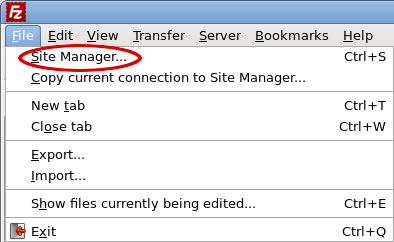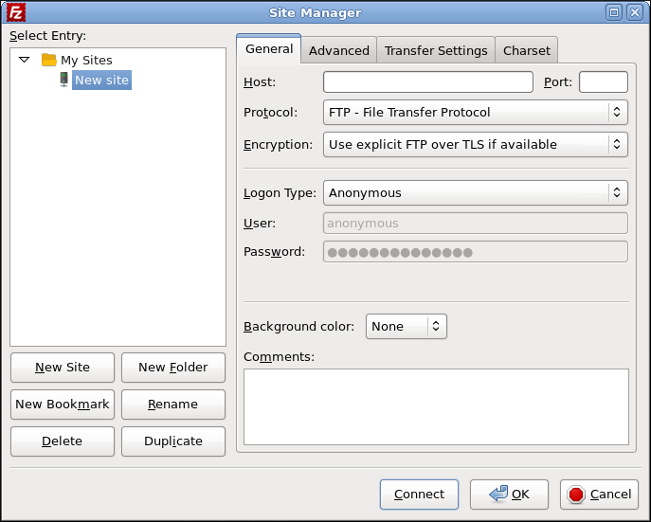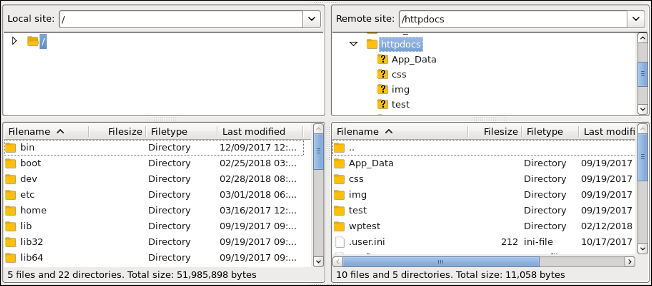Using FTP with Linux hosting accounts
FTP lets you to transfer files to and from your hosting.com account. This article demonstrates how to set up and use an FTP client with our hosting packages.
This article describes how to connect to your hosting.com account using an FTP (File Transfer Protocol) client.
ImportantFor general information about what FTP is and when you might use it, please see this article.
Using an FTP client
There are numerous FTP clients available, and many of them support SFTP (Secure FTP) and FTPS (FTP Secure) as well. hosting.com recommends FileZilla, a free program that you can download here. It supports all three protocols (FTP, SFTP, and FTPS), and runs on Microsoft Windows, Apple macOS, and Linux. In the following procedures, we show how to use FileZilla to connect to your account and transfer files.
NoteYou do not have to use FileZilla. If you want to use a different FTP client, however, you will need the following information to connect to your account:
Domain name: Your web site's domain name. Alternatively, you can use your server name. (If you are using Cloudflare, use your server name.) For information about how to determine your account's server name, please see this article.
FTP account username: - For SFTP, you must use your cPanel username. Make sure you do not include your domain name. For example, type
username, do not type[email protected].
For FTPS, you can use either your cPanel username, or the username for an FTP user you have created in cPanel (for example, [email protected] ).
For FTP, you can use either your cPanel username, or the username for an FTP user you have created in cPanel (for example, [email protected] ).
Password: The password for the account you are using.
Port number: For SFTP connections, use the SSH port for your account. This is usually 22, but some hosting accounts use a different port for SSH, such as 7822.
Connecting to your account
To connect to your account using FileZilla, follow these steps:
-
Start FileZilla.
-
On the File menu, click Site Manager:

The Site Manager dialog appears:

-
Click New Site, type a name for the site, and then press Enter.
-
In the Host text box, type your site's domain name. Alternatively, you can type the server hostname instead. (If you are using Cloudflare, use the server hostname.)
TipFor information about how to determine your account's server name, please see this article.
-
If you want to connect using SFTP, type
22in the Port text box. Otherwise, leave the Port text box blank.NoteMake sure you use the correct SSH port number for your account. For example, some hosting accounts use a different port for SSH, such as 7822.
-
In the Protocol list box, select the protocol you want to use:
-
To use SFTP, select SFTP - SSH File Transfer Protocol.
-
To use FTPS, select FTP - File Transfer Protocol, and then in the Encryption list box, select Require explicit FTP over TLS.
-
To use regular FTP, select FTP - File Transfer Protocol, and then in the Encryption list box, select Only use plain FTP (insecure).
ImportantWe strongly recommend that you use SFTP or FTPS whenever possible. Regular FTP sends usernames and passwords in unencrypted plaintext, and is not secure.
-
-
In the Logon Type list box, select Normal.
-
In the User text box, type the account username you want to use:
-
If you are using SFTP, you must use your cPanel username. Make sure you do not include your domain name. For example, type
username, do not type[email protected]. -
If you are using FTPS or a regular FTP connection, you can use either your cPanel username, or the username for an FTP user you have created in cPanel (for example, [email protected] ).
-
-
In the Password text box, type the password for the account you specified in step 8.
ImportantRemember that your account password is not the same as your hosting.com Hosting Panel password.
-
Optionally, you can specify a default directory for FileZilla to open on the remote server after it connects. For example, many people prefer to have an FTP client access the website document root directory by default. To do this, follow these steps:
-
Click the Advanced tab.
-
In the Default remote directory text box, type /home/username/public_html, where username represents your hosting.com account (cPanel) username.
-
-
Click Connect. After a few seconds, FileZilla establishes the connection.
Transferring files
After FileZilla establishes a connection between your local computer and the hosting.com server, you can transfer files. FileZilla has a Local site pane that displays files on your local computer, and a Remote site pane that displays files in your account on the hosting.com server:

To transfer files using FileZilla, follow these steps:
-
Navigate through folders in the Local site and Remote site panes just as you would in Windows Explorer or the macOS Finder. To open a folder, double-click it.
-
To upload a file to the server, drag the file from the Local site pane to the Remote site pane. After the file transfer is complete, the file appears in the Remote site pane.
TipTo upload a file, you can also double-click it in the Local site pane.
-
To download a file to the local computer, drag the file from the Remote site pane to the Local site pane. After the file transfer is complete, the file appears in the Local site pane.
TipTo download a file, you can also double-click it in the Remote site pane.
-
You can also transfer entire folders at once:
-
To upload a folder to the server, drag the folder from the Local site pane to the Remote site pane.
-
To download a folder to the local computer, drag the folder from the Remote site pane to the Local site pane.
-
FTP logging
All FTP activity is monitored and recorded in our server FTP log files. If you need information from the log files, please open a support ticket at https://my.hosting.com. Alternatively, if you use a managed VPS or dedicated server, you can check the FTP logs located at /var/log/messages.
More information
To view the official FileZilla documentation, please visit http://wiki.filezilla-project.org/Documentation.
Related articles
Updated 9 days ago
